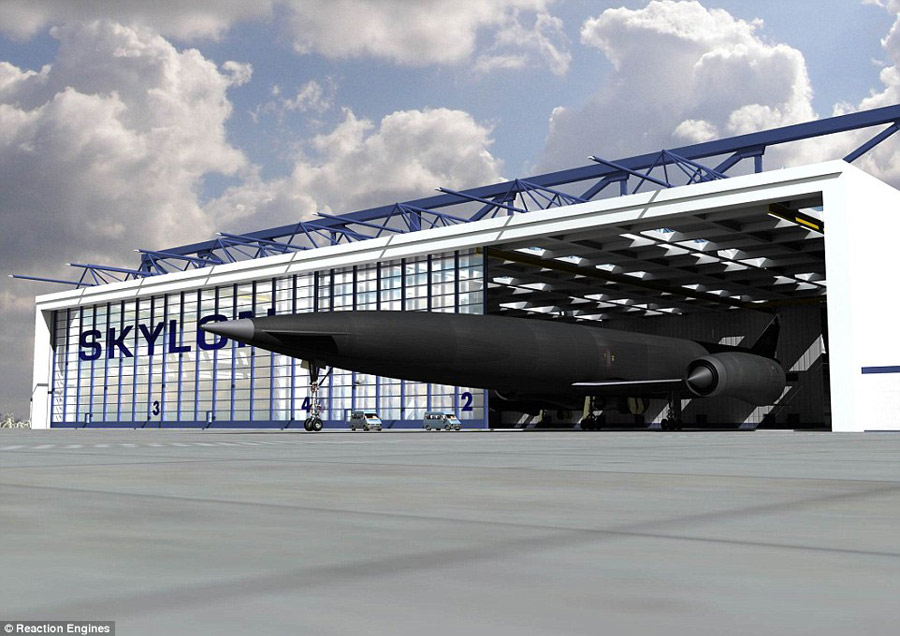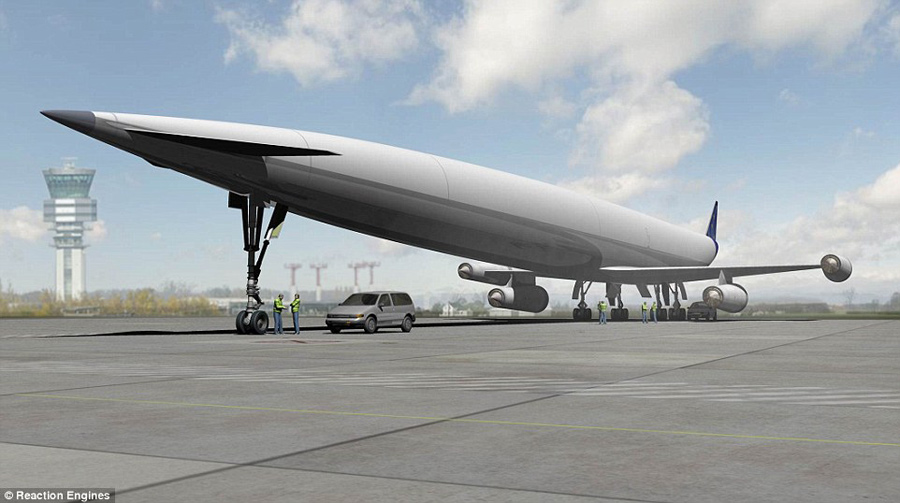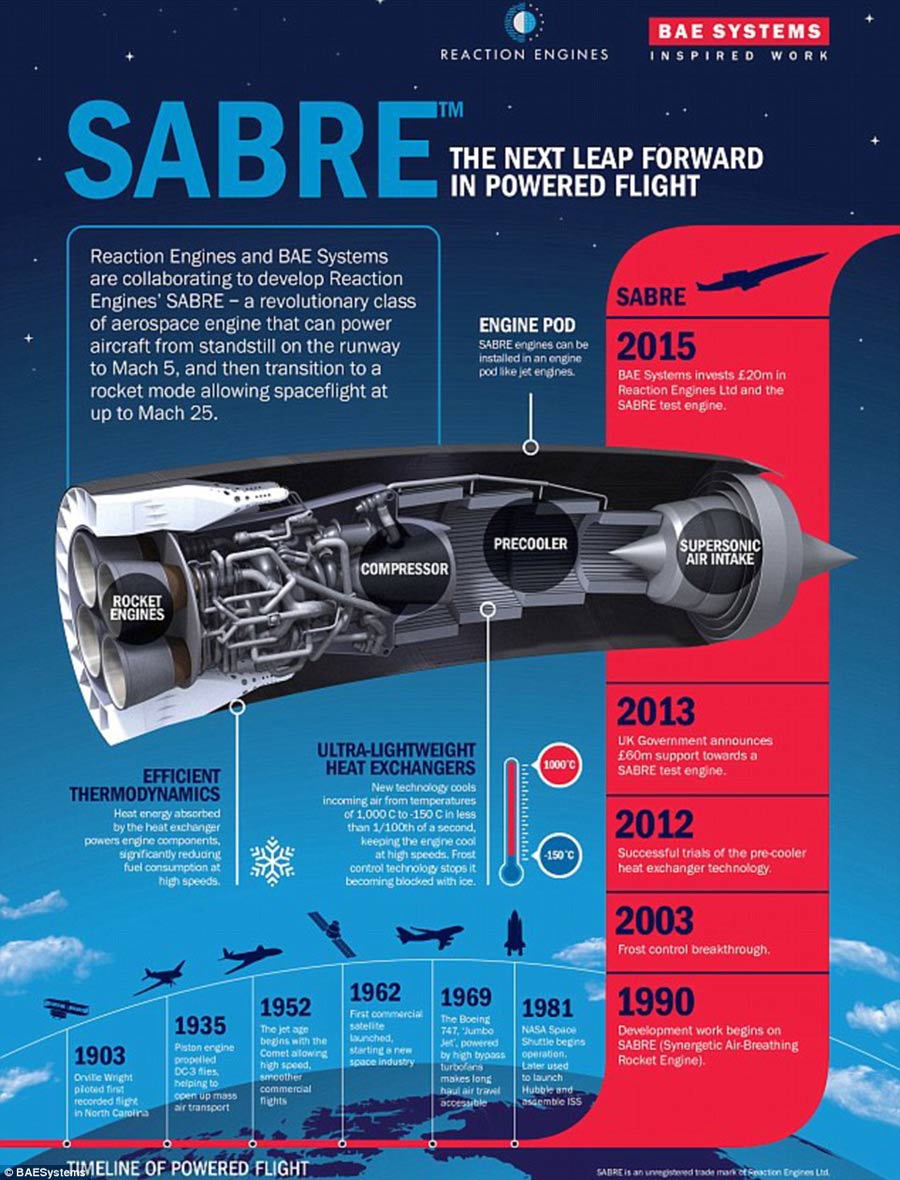

The European Space Agency has invested $11 million toward the development of an engine that could one day allow aircraft to fly anywhere in the world in just four hours.
Oxfordshire-based Reaction Engines has been developing a turbine that combines both jet and rocket technologies to achieve rates five times the speed of sound.
According to the firm, the new agreement with the ESA and the UK Space Agency, along with the existing partnership with BAE Systems, means that the first ground demonstrator engine could be ready for testing by 2020.

The European Space Agency has invested $11 million toward the development of a new type of engine that could one day allow aircraft to fly anywhere in the world in just four hours. Pictured, an artist's impression of the Lapcat A2 craft flying at Mach 5.
Reaction Engines announced today that it has secured over $66 million in funding from the British government, with more than $55 million from the UK Space Agency, and the ESA contribution acting as the final piece.
The revolutionary Sabre engine could allow aircraft to take off from a runway and accelerate to five times the speed of sound, before switching to a rocket mode, propelling it into orbit.
This design could also be used to send satellites into space at a fraction of the current cost.
‘We’ve had valuable support from ESA and UKSA to date, and today’s agreement is a further vote of confidence not only in the revolutionary potential of this technology, but our ability to deliver on it,’ said Mark Thomas, Chief Executive Officer of Reaction Engines Ltd.
‘We are now entering an exciting phase where we can accelerate the pace of development to get Sabre up and running.’

The revolutionary Sabre engine could allow aircraft to take off from a runway and accelerate to five times the speed of sound, before switching to a rocket mode, propelling it into orbit. Here, the Skylon spaceplane using the engine is shown.

Oxfordshire-based Reaction Engines has been developing a turbine that combines both jet and rocket technologies to achieve rates five times the speed of sound.
At the moment, rockets have to carry liquid oxygen and liquid hydrogen to power them and the cost of carrying this heavy fuel is expensive.
The new engine creates its own liquid oxygen by cooling air entering the engine from 1,000°C to minus 150°C in a hundredth of a second – six times faster than the blink of an eye – without creating ice blockages.
This allows the engine to run safely at much higher power than is currently possible, without the risk that it will overheat and break apart.
The design – known as an air-breathing rocket engine and named Sabre – could power a new generation of Mach 5 passenger jets, called the Lapcat, dramatically cutting flying times.
Mach 5 is about two and half times faster than the top speed achieved by Concorde and could be the next big leap forward in powered flight.
While normal long-haul passenger jets cruise at around 35,000ft, the Lapcat could fly as high as 92,000ft at speeds of up to 4,000mph.
Reaction Engine's Sabre design uses a system of pipes, filled with helium.
The air passes through these pipes and the helium helps remove any heat and the oxygen is carried to the engine.

The new engine creates its own liquid oxygen by cooling air entering the engine from 1,000°C to minus 150°C in a hundredth of a second – six times faster than the blink of an eye – without creating ice blockages.
Once in space, the engine is capable of switching into rocket mode.
This means the craft can travel in orbit for around 36 hours and used to launch satellites, for example.
‘We want the UK to be the best place in Europe to innovate and the Sabre engine programme has the potential to change air and space travel forever,’ said Katherine Courtney, acting Chief Executive Officer, UK Space Agency.
‘When the UK Space Agency made its £60m commitment in 2013, we demonstrated our courage and belief in the development of this ground-breaking technology.
‘Drawing on the expertise of the European Space Agency, our funding will help ensure that Reaction Engines and industry can collaborate to make this revolutionary engine a reality.’

The new engine creates its own liquid oxygen by cooling air entering the engine from 1,000°C to minus 150°C in a hundredth of a second – six times faster than the blink of an eye – without creating ice blockages.
In November, it was announced that BAE would take a 20 percent stake in the privately-owned Reaction for £20million.
Reaction’s Mark Thomas described the development of the engine at the time as the 'Holy Grail' of space access.
He said: 'The general public many feel removed from the notion of space, but much of our lives are reliant on the use of satellites in space.
'Because of its reusability, it dramatically reduces the cost of launching a satellite to about one tenth of the current $100 million.
'You don't buy a new car, and then when it runs of fuel throw it away.
'That is what we are aiming to do with spacecraft.'
BAE will be developing an aircraft fitted with the new engine.
The team plans to produce a demonstration model by the end of the decade, although designs for passenger aircraft are still at least 20 years away.

Reaction Engines announced today that it has secured over $66 million in funding from the British government. In November, it was announced that BAE would take a 20 percent stake in the privately-owned Reaction for £20million.
Day|Week

 Thai most beautiful transgender Nong Poy release new photos
Thai most beautiful transgender Nong Poy release new photos Top 10 livable Chinese cities
Top 10 livable Chinese cities The last primitive tribe in China
The last primitive tribe in China China's first intelligent security robot debuts in Chongqing
China's first intelligent security robot debuts in Chongqing A Total of 3,552 Subscribers Vanish In Two Days; YouTube Closes All Doors to Users’ Inquiries
A Total of 3,552 Subscribers Vanish In Two Days; YouTube Closes All Doors to Users’ Inquiries Out of this world! Futuristic UFO-shaped yacht has its own garden and a stunning underwater viewing deck
Out of this world! Futuristic UFO-shaped yacht has its own garden and a stunning underwater viewing deck An old tea house in Chengdu
An old tea house in Chengdu Furious Customer Crushes All the Buns from Vendor Just Because He Was Given the Wrong Flavor
Furious Customer Crushes All the Buns from Vendor Just Because He Was Given the Wrong Flavor 20 post-90s couples hold ’naked marriage‘ in E. China
20 post-90s couples hold ’naked marriage‘ in E. China Female official wearing traditional Han costume to promote local tourism
Female official wearing traditional Han costume to promote local tourism